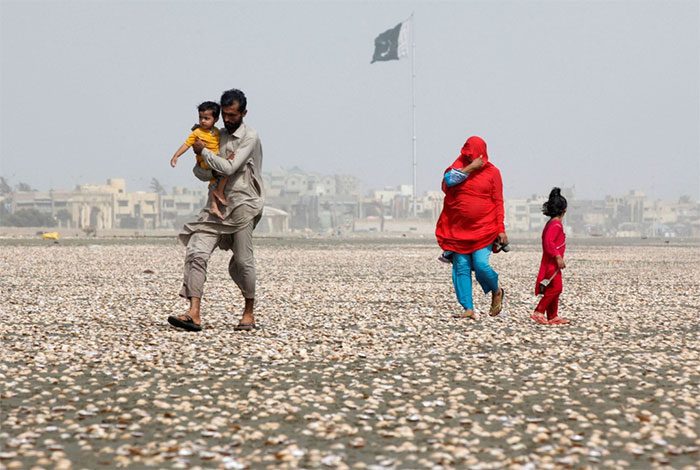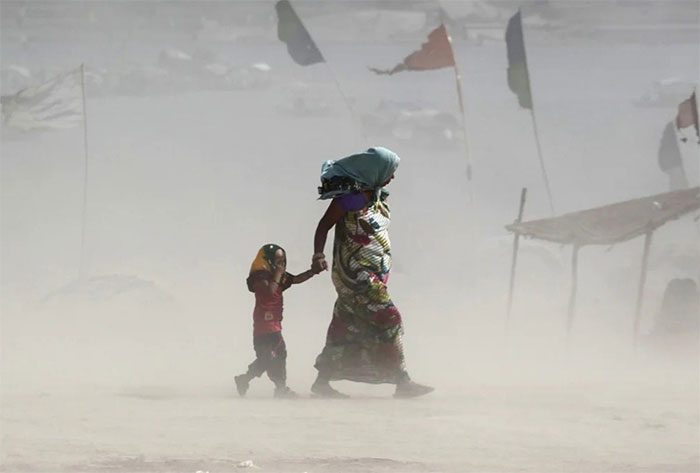Early heatwaves in Asian countries catch many off guard, leading to significant repercussions.
To adapt to heat, the body employs various responses, such as sweating and increasing blood flow to the skin to cool the internal organs.
Sweat becomes more abundant and diluted to minimize electrolyte loss. Simultaneously, the body slows down its metabolism and heart rate to consume less oxygen and maintain a lower internal temperature.
However, these responses take weeks of continuous exposure to heat to activate. The body functions best when heat does not arrive abruptly, allowing for a gradual adaptation process.
Yet, climate change is complicating matters. The summer is becoming longer and harsher, overshadowing winter and extending into autumn.
In Asia, China, India, Bangladesh, and Thailand have reported record high temperatures exceeding 40 degrees Celsius in the past two weeks, according to Axios. Early heatwaves may leave many unable to adapt, resulting in numerous health issues.
Higher Mortality Rates at the Start of the Season
While late summer temperatures are typically more severe, early heatwaves can lead to particularly dangerous consequences.
“There is substantial evidence showing that mortality rates are higher at the start of the season because people do not (have time to) adapt to the temperatures,” said Kristie Ebi, a professor of global health at the University of Washington.
The adaptation process to climate can also explain the uneven incidence of heat-related deaths across regions, according to Patrick Kinney, a public health researcher at Boston University.
“In northern parts of the U.S., like Boston, New York, or Chicago, many people may die even if temperatures are not excessively high, while in places like Atlanta or Houston, it takes significantly higher temperatures for mortality rates to increase,” he stated.
Scientists propose several theories regarding the higher number of early summer deaths compared to late summer. One hypothesis suggests that the most vulnerable population groups (the elderly and those with chronic illnesses) may struggle to cope with temperature changes early in the season, leading to fewer vulnerable individuals during the harsher heatwaves that follow after a few months.
The second explanation is the adaptation effect. “Each person adapts at a different rate, depending on their age, physiology, or previous heat exposure,” Ebi noted.
Particularly vulnerable populations include those over 65, children under one year old, users of certain prescription medications, individuals with chronic illnesses, outdoor workers and farmers, the homeless, and pregnant women.
Research also indicates a link between exposure to high temperatures in the last three months and reduced birth weights in newborns.

Heatwaves are sweeping across many Asian countries. (Photo: Alarmy).
According to Vox, climate change is leading to many unusual issues. One of these is nights being much warmer than before.
The ability to cool down at night is one of the critical factors in preventing heat-related illnesses. However, the phenomenon of warm nights is disrupting sleep and causing stress on the body.
“Overall, since 1895, overnight summer temperatures have been rising at nearly twice the rate of afternoon temperatures in the U.S.,” reported the National Oceanic and Atmospheric Administration (NOAA).
Additionally, regions must consider the differences between humid and dry heat. Humidity makes people feel warmer, so areas accustomed to dry heat waves may struggle to adapt to different conditions.
Climate change is making the risk of heat-related injuries not limited to July and August. Experts like Ebi suggest that we need to rethink the risks of heat year-round in order to better prepare and assist the most vulnerable individuals during critical times.
Inequality
The ability to adapt to early heat is influenced not only by physiological changes in the body. Behavior, policies, and infrastructure also create disparities.
People unaccustomed to hot weather may cope by turning on air conditioning sooner, staying cool with water or shade. Green landscapes and breathable clothing can also help regulate temperature.
However, access to these resources varies significantly based on income, race, geography, and politics.
“In some respects, heat is a natural phenomenon, but political choices over decades and centuries have stripped vital resources, infrastructure, disaster preparedness, and green amenities from low-income communities of color,” stated Michael Méndez, an assistant professor of environmental policy at the University of California, Irvine.
“And it is no surprise that when disasters occur, the communities most heavily impacted are often the least prepared,” he remarked.
Trees are a prime example of this disparity. Racially segregated areas have significantly less tree cover compared to non-segregated areas.
Research conducted by Dr. Dexter Locke, a social scientist at the Urban Forest Research, Environmental Quality, and Human Health unit of the U.S. Forest Service, and colleagues estimates this disparity to be about 21 percentage points.
Schools are also unevenly equipped to handle heat. According to a study published in the journal Nature Human Behavior, across 58 countries, for each additional day with temperatures above 26.67 degrees Celsius, children’s test scores decline.
When analyzing U.S. data, researchers found a pronounced impact of heat on Black and Hispanic students, noting that they may have less access to air conditioning at home and in schools.

Inequality makes coping with heat more challenging in certain communities. (Photo: Reuters).
Méndez also pointed out that “agricultural workers have a mortality rate 35 times higher than in other industries, particularly among Latinx individuals and migrant farmworkers.”
Even measures to cope with heatwaves, such as opening cooling centers, supporting energy bills, and preventing power outages, do not focus on the critical early season when people struggle most to adapt to high temperatures.
These solutions often do not begin until temperatures exceed 35 degrees Celsius, well beyond the threshold that some vulnerable populations can handle.
Therefore, reducing the risks of heatwaves requires countries to invest more in preparing for early heatwaves.
“We are hardly equipped to deal with what is happening. With climate change, we are witnessing the increasing frequency, intensity, and duration of heatwaves, so we need to adjust our response strategies,” stated Ladd Keith, a professor of urban planning at the University of Arizona.




















































